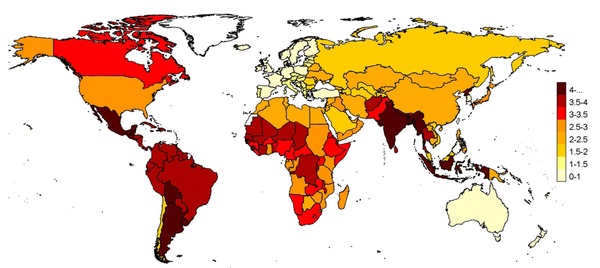The modest number of 18,449 laboratory-confirmed deaths from the 2009 H1N1 influenza pandemic caused many to question whether the response was excessive. A recent World Health Organization (WHO) study analyzing the global mortality of the 2009 H1N1 influenza pandemic contradicted this previous mortality estimate. The new study published in PLoS Medicine found mortality rates may have been 10 times higher than previously estimated, killing 123,000 to 203,000 people from respiratory illness. Researchers combined data from WHO and mortality statistics from 21 countries, which accounted for approximately 35 percent of the world’s population, to estimate mortality. These results were then projected globally. These recent estimates closely match that of a Centers for Disease Control and Prevention study published last year which estimated 201,000 people died of influenza and respiratory causes and another 83,000 died of related cardiac problems.

Image from “Global Mortality Estimates for the 2009 Influenza Pandemic from the GLaMOR Project: A Modeling Study”
Increased deaths among persons under the age of 65 – While the newly estimated mortality range of 123,000-203,000 deaths is comparable to that of a normal influenza season, the analysis concluded that 62 to 85 percent of the people who died were younger than the age of 65. During an average pre-pandemic season, only 19 percent of respiratory deaths are in individuals younger than the age of 65. This marked shift toward mortality in younger persons resulted in many more life-years lost. Another study (Van Kerkhove et al., 2011) reported a median age of 46 among fatal laboratory-confirmed cases.
Influenza-attributable deaths from heart failure and other secondary consequences – Some deaths attributed to influenza are recorded as having been caused by underlying non-respiratory causes such as heart attack, stroke, diabetes, or chronic kidney conditions. Researchers were able to estimate influenza-attributable “excess” deaths in broad categories such as pneumonia, respiratory, or cardiorespiratory deaths during the pandemic period. Analysis of influenza-attributable “excess” deaths pushed overall mortality to approximately 400,000 deaths.
Factors contributing to global differences in mortality – The mortality burden varied greatly among countries, with up to a 20-fold higher mortality in Central and South American countries than in European countries. Factors suggested to have contributed to global difference in mortality include the previous influenza exposure history of the population, the use of antiviral medication, the number and duration of pandemic waves, influenza vaccination coverage in preceding seasons, access to intensive care, and use of public health mitigation strategies. Researchers have also hypothesized that when a population had been exposed to an H1N1 seasonal strain that was distantly related to the pandemic virus strain, their previous exposure can result in a more severe reaction. In the 2008-2009 influenza season, H1N1 predominated in the Americas and H3N2 in Europe.
This study demonstrated the heterogeneous impacts of pandemics in different regions and subsets of populations. This variation shows how difficult it can be to prepare and respond to a pandemic. Assessing the mortality of the most recent influenza pandemic is critical to enhancing the public health response to future pandemics. Local health departments should continue to explore effective ways to educate the public and disseminate information regarding the risks of influenza, the importance of vaccinations to prevent influenza, and antiviral medication for treatment of seasonal and pandemic influenza.
Currently, researchers are keeping an eye on two influenza strains – H7N9 and H5N1. The H1N1 virus has joined other seasonal influenza viruses that continue to circulate in the United States and abroad.
NACCHO pandemic influenza resources:
- Tools and Resources for Influenza Preparedness
- Influenza Toolkit
- STOCKbox Toolkit
- No Flu For You! (An evidence based influenza education campaign), NACCHO Model Practice
- WebEOC Utilization for Seasonal Influenza Reporting, NACCHO Model Practice
- Pandemic Influenza Planning — Partnership with County Emergency Management and Human Services, NACCHO Model Practice
Other pandemic influenza resources:
- Resources for Pandemic Flu, Centers for Disease Control and Prevention
- Pandemic Awareness, FLU.gov
- Global Influenza Programme, World Health Organization
Recent news articles on this study:








